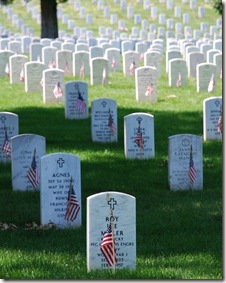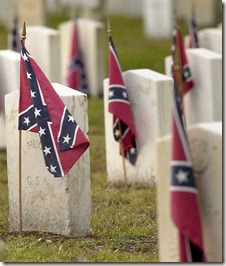 Memorial Day is a United States federal holiday observed on the last Monday of May (May 30 [Today] in 2011). Formerly known as Decoration Day, it commemorates men and women who died while in military service to the United States. First enacted to honor Union and Confederate soldiers following the American Civil War, it was extended after World War I to honor Americans who have died in all wars.
Memorial Day is a United States federal holiday observed on the last Monday of May (May 30 [Today] in 2011). Formerly known as Decoration Day, it commemorates men and women who died while in military service to the United States. First enacted to honor Union and Confederate soldiers following the American Civil War, it was extended after World War I to honor Americans who have died in all wars.
Memorial Day often marks the start of the summer vacation season, and Labor Day its end.
Begun as a ritual of remembrance and reconciliation after the civil war, by the early 20th century, Memorial Day was an occasion for more general expressions of memory, as ordinary people visited the graves of their deceased relatives, whether they had served in the military or not.
History
 By 1865 the practice of decorating soldiers' graves had become widespread in the North. The first known observance was in Boalsburg, Pa on October, 1864, and each year thereafter. The friendship between General John Murray, a distinguished citizen of Waterloo, and General John A. Logan, who helped bring attention to the event nationwide, was likely a factor in the holiday's growth. On May 5, 1868, in his capacity as commander-in-chief of the Grand Army of the Republic – the organization for Northern Civil War veterans – Logan issued a proclamation that "Decoration Day" should be observed nationwide. It was observed for the first time on May 30 of the same year; the date was chosen because it was not the anniversary of a battle.
By 1865 the practice of decorating soldiers' graves had become widespread in the North. The first known observance was in Boalsburg, Pa on October, 1864, and each year thereafter. The friendship between General John Murray, a distinguished citizen of Waterloo, and General John A. Logan, who helped bring attention to the event nationwide, was likely a factor in the holiday's growth. On May 5, 1868, in his capacity as commander-in-chief of the Grand Army of the Republic – the organization for Northern Civil War veterans – Logan issued a proclamation that "Decoration Day" should be observed nationwide. It was observed for the first time on May 30 of the same year; the date was chosen because it was not the anniversary of a battle.
There were events in 183 cemeteries in 27 states in 1868, and 336 in 1869. The northern states quickly adopted the holiday; Michigan made "Decoration Day" an official state holiday in 1871 and by 1890 every northern state followed suit. The ceremonies were sponsored by the Women's Relief Corps, which had 100,000 members. By 1870, the remains of nearly 300,000 Union dead had been buried in 73 national cemeteries, located mostly in the South, near the battlefields. The most famous are Gettysburg National Cemetery in Pennsylvania and Arlington National Cemetery, near Washington.
The Memorial Day speech became an occasion for veterans, politicians and ministers to commemorate the war – and at first to recall the atrocities of the enemy. They mixed religion and celebratory nationalism and provided a means for the people to make sense of their history in terms of sacrifice for a better nation, one closer to their God. People of all religious beliefs joined together, and the point was often made that the German and Irish soldiers had become true Americans in the "baptism of blood" on the battlefield. By the end of the 1870s the rancor was gone and the speeches praised the soldiers of both the Union and Confederacy. By the 1950s, the theme was American exceptionalism and duty to uphold freedom in the world. In 1882, the name of Decoration Day was formally changed to Memorial Day in "memory" and 'honor" of those who gave their lives fighting for a common cause, America.
In the South
In Charleston, South Carolina in 1865, freedmen (freed enslaved Africans) celebrated at the Washington Race Course, today the location of Hampton Park. The site had been used as a temporary Confederate prison camp for captured Union soldiers in 1865, as well as a mass grave for Union soldiers who died there. Immediately after the cessation of hostilities, freedmen exhumed the bodies from the mass grave and reinterred them in individual graves. They built a fence around the graveyard with an entry arch and declared it a Union graveyard. On May 1, 1865, a crowd of up to ten thousand, mainly black residents, including 2800 children, proceeded to the location for events that included sermons, singing, and a picnic on the ground, thereby creating the first Decoration Day-type celebration.
 Beginning in 1866 the Southern states had their own Memorial Days, ranging from April 26 to mid June. The birthday of Confederate President Jefferson Davis, June 3, became a state holiday in 10 states by 1916. Across the South associations were founded after the war to establish and care for permanent cemeteries for Confederate soldiers, organize commemorative ceremonies, and sponsor impressive monuments as a permanent way of remembering the Confederate tradition. Women provided the leadership in these associations, paving the way to establish themselves as capable of public leadership.
Beginning in 1866 the Southern states had their own Memorial Days, ranging from April 26 to mid June. The birthday of Confederate President Jefferson Davis, June 3, became a state holiday in 10 states by 1916. Across the South associations were founded after the war to establish and care for permanent cemeteries for Confederate soldiers, organize commemorative ceremonies, and sponsor impressive monuments as a permanent way of remembering the Confederate tradition. Women provided the leadership in these associations, paving the way to establish themselves as capable of public leadership.
The earliest Confederate Memorial Day celebrations were simple, somber occasions for veterans and their families to honor the day and attend to local cemeteries. Around 1890, there was a shift from this consolatory emphasis on honoring specific soldiers to public commemoration of the Confederate "Lost Cause". Changes in the ceremony's hymns and speeches reflect an evolution of the ritual into a symbol of cultural renewal and conservatism in the South. By 1913, however, the theme of American nationalism shared equal time with the Lost Cause.
Columbus, Mississippi at its Decoration Day on April 25, 1866, commemorated both the Union and Confederate casualties buried in its cemetery.
2 comments:
I hope everyone today pays tribute to our fallen heros, and those still serving our country.
Peace (God, we need more of this) <3 (couldn't hurt to throw in a little of that, either)
Jay
I always hope for peace, Jay. People fight over far too much when they should just have cooler heads, but we still must pay tribute to our fallen heroes.
Post a Comment